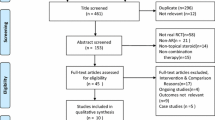Abstract
There are limited numbers of articles, studying combined use of antihistamines. In this study, we compare single therapy of Apo-Cetirizine with a new regimen of intermittent sequential therapy with cetirizine, loratadine and chlorpheniramine in treatment of seasonal allergic rhinitis. This randomized clinical trial was performed between April and September at the peak prevalence of seasonal allergic rhinitis. Fifty-four eligible patients diagnosed clinically to have seasonal allergic rhinitis were randomized in two groups: 24 cases in single therapy arm, received Apo-Cetirizine 10 mg tablet daily and in other arm, 30 patients received sequential regimen of cetirizine 10 mg tablet, loratadine 10 mg tablet and chlorpheniramine 4 mg tablet, one tablet each day. Major Symptom Complex Score (MSCS) and Total Symptom Complex Score (TSCS) of patients were recorded before treatment and after 30 days of treatment in two groups. The average post-treatment MSCS and TSCS in combination therapy group showed better improvement than single therapy group but difference was not statistically significant (p value = 0.053 and p value = 0.104 respectively). Combination therapy regimen was better in improvement of nasal congestion (p value = 0.006). There were no significant difference between two groups in efficacy, side effects and patient’s satisfaction. Combination therapy would be effective on a wide spectrum of symptoms with lower price and theoretically offers lower chance of tolerance and re-appearance of complaints.



Similar content being viewed by others
References
Bazzazi H, Gharagozlou M, Kassaiee M, Parsikia A, Zahmatkesh H (2007) The prevalence of asthma and allergic disorders among school children in Gorgan. J Res Med Sci 12:28–33
Sahebi L, SadeghiShabestari M (2011) The prevalence of asthma, allergic rhinitis and eczema among middle school students in Tabriz (northwestern Iran). Turk J Med Sci 41:927–938
Mirsaid Ghazi B, Imamzadegan R, Aghamohammadi A, DarakhshanDavari R, Rezaei N (2003) Frequency of allergic rhinitis in school age-children (7–18 years) in Tehran. Iran J Allergy Asthma Immunol 2:181–184
Settipane RA (2001) Demographics and epidemiology of allergic and nonallergic rhinitis. Allergy Asthma Proc 22:185–189
Stuck BA, Czajowski J, Hagner AE, Klimek L, Verse T, Hormann K et al (2004) Changes in daytime sleepiness, quality of life and objective sleep patterns in seasonal allergic rhinitis: a controlled clinical trial. J Allergy Clin Immunol 113:663–668
Lehman JM, Blaiss MS (2006) Selecting the optimal oral antihistamines for patients with allergic rhinitis. Drugs 66:2309–2319
Woods L, Craig TJ (2006) The importance of rhinitis on sleep, daytime somnolence, productivity and fatigue. Curr Opin Pulm Med 12:390–396
Crystal-Peters J, Crown WH, Goetzel RZ, Schutt DC (2000) The cost of productivity losses associated with allergic rhinitis. Am J Manag Care 6:373–378
Scadding G, Hellings P, Alobid I, Bachert C, Fokkens W, van Wijk RG et al (2011) Diagnostic tools in rhinology EACCI position paper. Clin Transl Allergy 1:1–39
Di Lorenzo G, Pacor ML, Amodio E, Leto-Barone MF, La Piana S, D’Alcamo A et al (2011) Differences and similarities between allergic and nonallergic rhinitis in a large sample of adult patients with rhinitis symptoms. Int Arch Allergy Immunol 155:263–270
Walls AF, He S, Buckley MG, McEuen AR (2001) Roles of the mast cell and basophil in asthma. Clin Exp Allergy Rev 1:68
Hansen I, Klimek L, Mosges R, Hormann K (2004) Mediators of inflammation in the early and the late phase of allergic rhinitis. Curr Opin Allergy Clin Immunol 4:159–163
Ahmad N, Zacharek MA (2008) Allergic rhinitis and rhinosinusitis. Otolaryngol Clin N Am 41:267–281
Bachert C (2009) A review of the efficacy of desloratadine, fexofenadine and levocetirizine in the treatment of nasal congestion in patients with allergic rhinitis. Clin Ther 31:921–944
Baddorrek P, Dick M, Schaureta A, Hecker H, Murdoch R, Luetig B et al (2009) A combination of cetirizine and pseudoephedrine has the therapeutic benefits when compared to single drug treatment in allergic rhinitis. Int J Clin Pharmacol Ther 47:71–77
Grossman J (1989) Loratadine–pseudoephedrine combination versus placebo in patients with seasonal allergic rhinitis. Ann Allergy 63:317–321
Wallace DV, Dykewicz MS, Bernstein DI, Blessing-Moore J, Cox L, Khan DA et al (2008) The diagnosis and management of rhinitis: an updated practice parameter. J Allergy Clin Immunol 122:S1–S84
Heffernan M, Hirsh JG, Rariy RV (2008) Antihistamine combination. Collegium Pharmaceutical US 20080207593
Day JH, Briscoe MP, Rafeiro E, Ratz JD (2004) Comparative clinical efficacy, onset and duration of action of levocetirizine and desloratadine for symptoms of seasonal allergic rhinitis in subjects evaluated in the environmental exposure unit (EEU). Int J Clin Pract 58:109–118
Sly RM (1999) Changing prevalence of allergic rhinitis and asthma. Ann Allergy Asthma Immunol 82:233–248
von Mutius E, Weiland SK, Fritzsch C (1998) Increasing prevalence of hay fever and atopy among children in Leipzig, East Germany. Lancet 351:862–866
Tkachyk SJ (1999) New treatments for allergic rhinitis. Can Fam Physician 45:1255–1260
Storms WW (2004) Pharmacologic approaches to daytime and nighttime symptoms of allergic rhinitis. J Allergy Clin Immunol 114(5 suppl):S46–S53
Simons FE (2004) Advances in H1-antihistamines. N Engl J Med 351:2203–2217
Conflict of interest
Authors declare no conflict of interest.
Author information
Authors and Affiliations
Corresponding author
Rights and permissions
About this article
Cite this article
Safavi Naini, A., Ghorbani, J. & Mazloom, E. Comparative Study of Apo-Cetirizine Single Therapy and Intermittent Sequential Therapy with Cetirizine, Loratadine and Chlorpheniramine in Allergic Rhinitis. Indian J Otolaryngol Head Neck Surg 68, 329–333 (2016). https://doi.org/10.1007/s12070-014-0753-z
Received:
Accepted:
Published:
Issue Date:
DOI: https://doi.org/10.1007/s12070-014-0753-z




